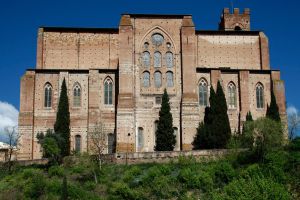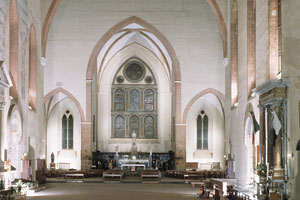The Basilica of San Domenico
Architecture
The Basilica of San Domenico is a splendid example of Gothic architecture typical of the Dominican mendicant orders of the thirteenth and fourteenth centuries. Built between 1225 and 1265, in the course of the fourteenth century it was enlarged into the simple, majestic form we still see today.
From the height of the Camporegio hill (tradition claims that King Henry IV camped there during the siege of 1186, hence the name, which means “royal camp”), it dominates the Oratory of the Contrada dell’Oca (formerly the space occupied by the Benincasa dyers), the Church of the Crucifix, and Saint Catherine’s House.
In the aesthetic sobriety of its forms and its impressive bulk, ideal for holding the greatest number of faithful, the Basilica responds to the Dominicans’ evangelization needs; they built it near the city in order to pursue their work of teaching and spiritual direction in close contact with the community of Siena.
The entire structure is made of bricks, and its exterior is distinguished by its lack of decoration; the only elements breaking up the expanse of wall surface are the long, narrow slits created to flood the church interior with light. Gothic architecture, in fact, sought to have the greatest illumination possible; light, a sign of God, entered and with its brightness chased away the darkness of the human condition.
The entrance to the Basilica is . . .




